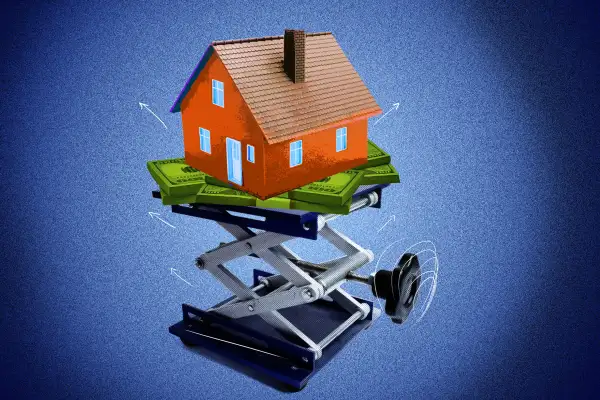How to Use Your Home Equity to Pay Off Debt

When you’re squirreling away money to pay off debt, you may be overlooking one of the largest assets that could help: your home.
Borrowing against your home equity — or the difference between how much your home is worth and how much is left on your mortgage — could be the key to consolidating debt and ultimately saving a ton on interest.
Homeowners in the U.S. are currently sitting on a record high of more than $35 trillion in home equity, according to the Federal Reserve Bank of St. Louis. That’s the case even as Americans are also racking up credit card debt — owing a collective $1.14 trillion.
The result is a rebound in interest for home equity lines of credit, or HELOCs. These products, sometimes referred to as second mortgages, allow you to borrow and spend up to a certain credit limit, then repay the money on a schedule agreed upon between you and your lender. While demand for this type of financing fell for much of the 2010s, it’s now jumped 20% since 2021, the Federal Bank of New York recently reported.
Read on for the pros and cons of using HELOCs as a debt consolidation tool, plus how to use the equity in your home to pay off your debt.
Pros and cons of using a HELOC to pay off your debts
If you’ve built up a significant amount of debt, especially high-interest debt like credit card balances, a HELOC can be useful in snagging a lower interest rate. The rates on HELOCs today start at roughly 9% — significantly lower than the average annual percentage rate (APR) on credit cards, which is above 22%, and lower than even some of the best personal loans.
Because HELOCs don’t typically give you a lump-sum payment, they also offer a bit more flexibility than other types of loans. These products are revolving lines of credit, which means you can take the money as needed out of the total amount approved and control how much debt you accumulate. You only pay interest on the amount you’ve actually withdrawn from your line of credit.
There’s also flexibility around how you use the HELOC, since there aren’t any restrictions dictating what you have to put the money toward. (Home equity loans, a cousin to the HELOC, work similarly but they are distributed as a lump sum, and you’ll start paying interest on the full amount immediately.)
In the past, interest paid on a HELOC was tax deductible regardless of how you spent it. Those rules have changed and now the proceeds have to be used on home projects for the income to be eligible for a tax deduction, though that could change again in the future. (If this is an important detail for you, it’s always best to consult with a tax advisor.)
Like many financial products, HELOCs come with downsides, too.
“You are borrowing against your home equity and you’re putting your house up as collateral, so in the worst case scenario, the lender essentially has a lien on your house,” says Glenn Downing, founder and principal of investment advisory firm CameronDowning. “You’re putting your family’s residence on the hook.”
And if the value of that home drops, you could end up owing more than what your home is worth.
Some lenders offer fixed-rate HELOCs that are ideal for debt consolidation. But generally speaking, HELOCs come with variable interest rates, which means you may not be able to lock in a low fixed rate and may have to deal with fluctuations in your expected payments. Translation: You’ll pay more when interest rates go up.
HELOCs can also make it tempting to take on more debt. You can typically get a HELOC that's worth up to 85% of your home equity. That means if you have $150,000 worth of equity, you could have access to a credit line up to $127,500 — much more than you may need to pay off your high-interest debt. Mike Miller, a financial advisor at Integra Shield Financial Group, says that he always asks clients who are interested in HELOCs why they need that extra cash.
“There may be some underlying issue there related to spending,” Miller says.
How to use a HELOC to pay off your loans
When you use a HELOC or home equity loan to consolidate your debts, you’re essentially borrowing from one source (your home) to pay off other, more expensive sources of debt (like your credit cards).
When you first get a HELOC, your lender will determine how much of your home equity you can actually borrow against. During this initial step, be prepared to pay some upfront costs like application or origination fees.
After your loan has been funded, you can start spending during what’s called the borrowing period or draw period. You may have to take out an initial amount or borrow a minimum amount each time you withdraw from your line of credit, depending on the terms outlined in the HELOC agreement. As soon as you get the cash, you can start paying off your more expensive debts.
Typically with a HELOC, you spend the money as needed; that can make HELOCs useful if you want flexibility to first consolidate your debts and then have some access to additional credit over the coming years. In fact, Miller says he’ll sometimes encourage clients to establish a HELOC even if they don’t plan to immediately use the money, depending on their situation.
“It’s kind of like an emergency fund,” he adds.
If, on the other hand, you know you only want to use the money for a one-time credit card debt payoff, you may be better off with a home equity loan than a HELOC. With this loan, you can borrow exactly what you need to pay down your higher-rate balances, and then immediately start paying back the lower-rate debt.
During the borrowing period of a HELOC, which usually lasts five to 10 years, you can make payments on some of the principal plus the interest, or just the interest. Of course, in this case, the goal of using a HELOC is to make it easier to pay down your debts. To avoid a repeat where you're facing unaffordable payments again, it's best to pay more than just the interest so your payments don't balloon down the road.
Once the draw period is over, it’s time to enter the “repayment period” in which you’ll pay off the loan, often over 10 to 15 years, or pay off the entire balance, depending on your agreement. You can pay off your HELOC early, though your lender may charge a prepayment penalty.

